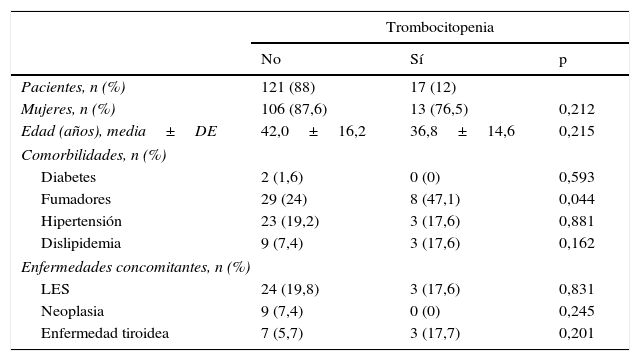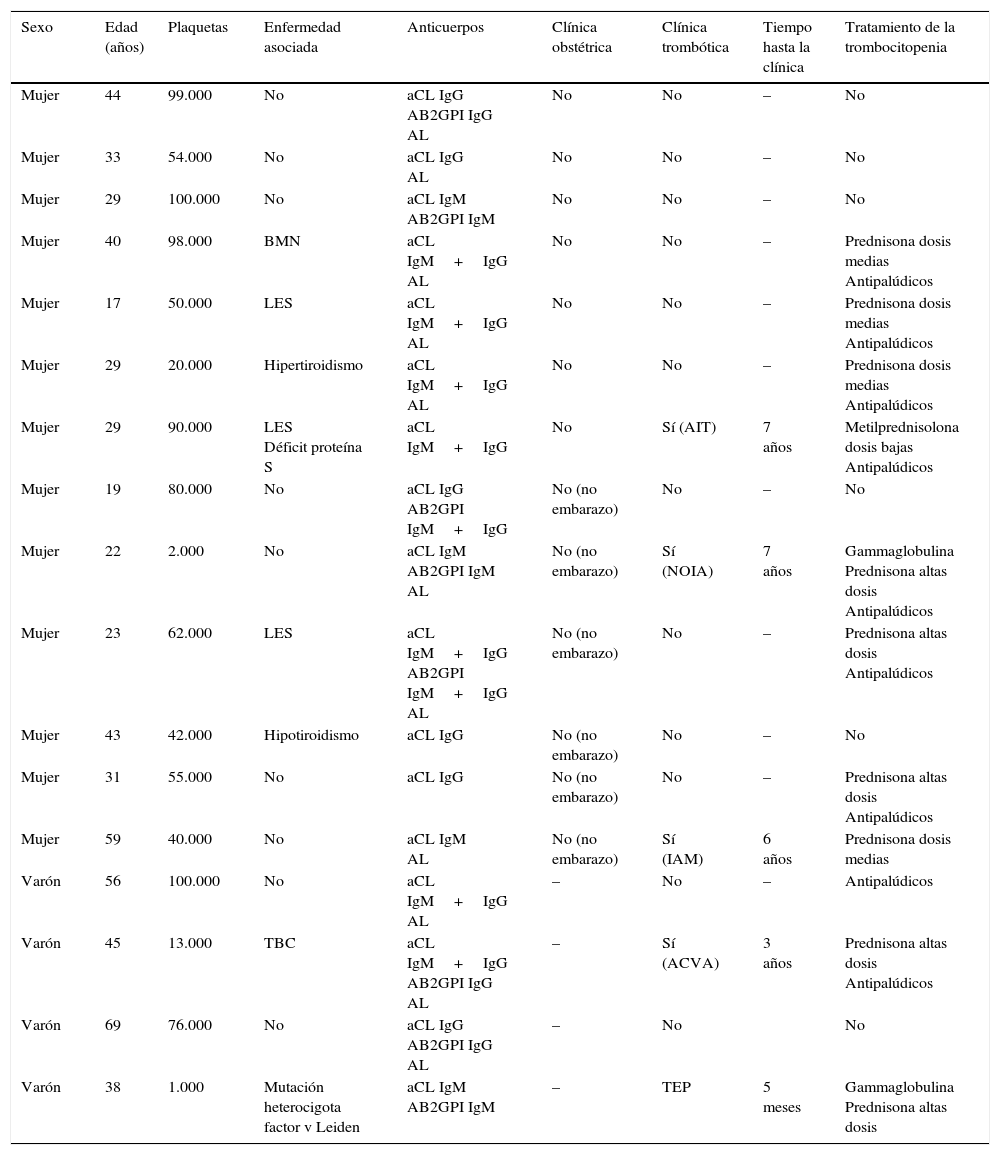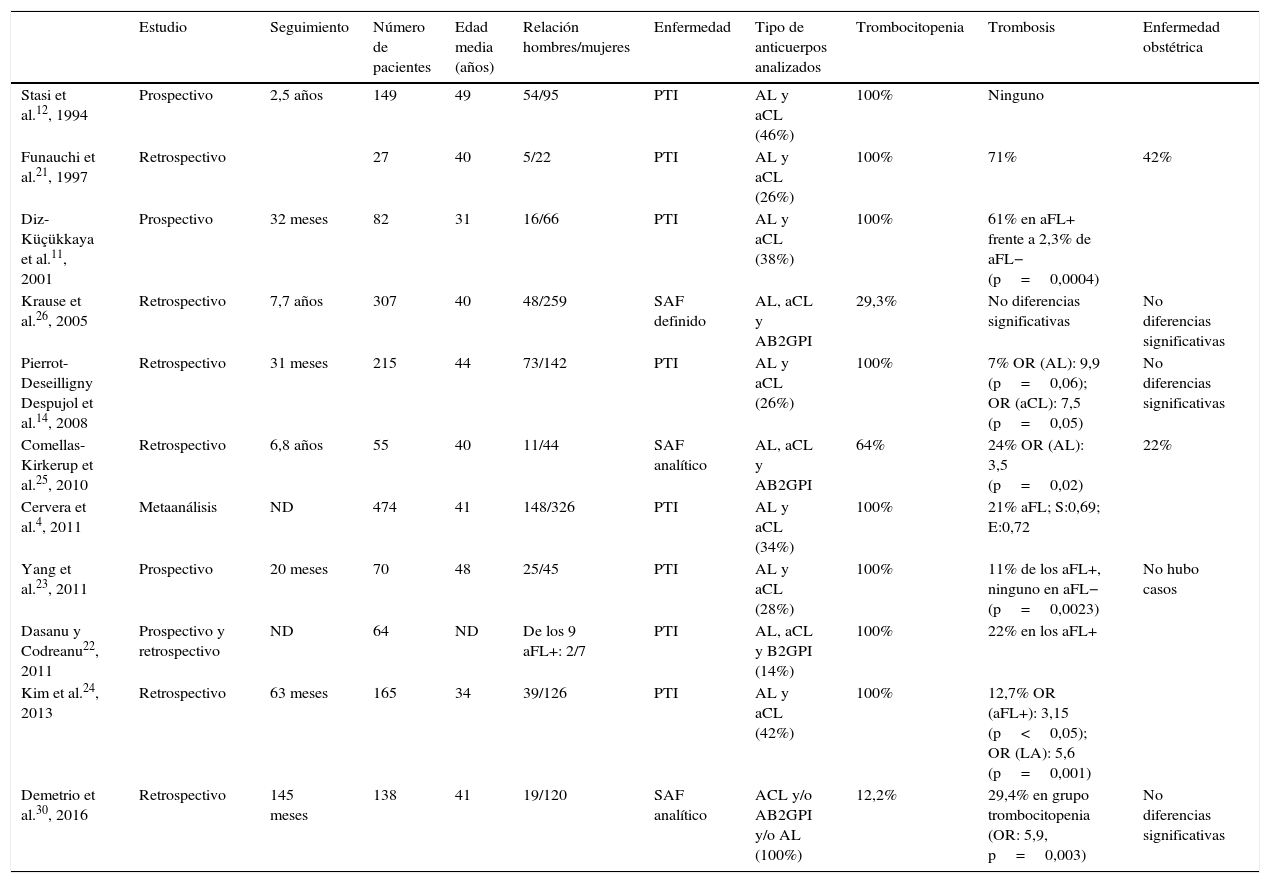El síndrome antifosfolípido (SAF) es un trastorno inmunitario adquirido, definido por la presencia de trombosis (arterial y/o venosa) y/o morbilidad del embarazo junto con la presencia de anticuerpos antifosfolipídicos (aFL) positivos. Existe una relación clara entre los aFL y algunas manifestaciones no incluidas en los criterios clínicos, entre ellas, las hematológicas.
Objetivosa) estudiar la probabilidad de desarrollar SAF clínico en pacientes con aFL positivos y trombocitopenia; b) identificar posibles factores de riesgo para trombosis, y c) estudiar la asociación entre trombocitopenia y aFL.
MétodosEstudio retrospectivo de 138 pacientes con aFL positivos sin cumplir criterios clínicos de SAF. Se definió trombocitopenia como una cifra de plaquetas≤100.000/μl. Se excluyeron los pacientes con otras causas de trombocitopenia.
ResultadosDiecisiete de los 138 (12%) pacientes incluidos en el estudio presentaban trombocitopenia. La cifra media de plaquetas fue de 60.000/μl. El riesgo para desarrollar trombocitopenia fue mayor en los pacientes fumadores (OR 2,8; p=0,044), en aquellos con anticoagulante lúpico (OR 13,5; p<0,001) y en los que tenían una mayor carga de aFL (OR 50,8; p<0,001). Tras un seguimiento medio de 146±60,3 meses, 5 pacientes con trombocitopenia (29,4%) desarrollaron trombosis.
ConclusionesEn nuestra serie, la incidencia de trombocitopenia es del 12%. Los pacientes con aFL positivos que desarrollan trombocitopenia tienen un riesgo potencial de desarrollar trombosis. El tabaco podría ser un factor de riesgo para trombocitopenia. La carga de autoanticuerpos es un factor de riesgo para el desarrollo de trombocitopenia.
The antiphospholipid syndrome (APS) is an acquired immune disorder defined by the presence of thrombosis (arterial and/or venous) and/or pregnancy morbidity along with the presence of positive antiphospholipid antibodies (aPL). There is a clear relationship between aPL and some events not included in the clinical criteria, including haematologic.
Objectivesa) to study the probability of developing clinical APS in patients with positive aPL and thrombopenia; b) to identify potential risk factors for thrombosis, and c) to study the association between thrombocytopenia and aPL.
MethodsA retrospective study of 138 patients with positive aPL without fulfilling clinical criteria for APS. Thrombocytopenia was defined as a platelet count≤100,000/μl. Patients with other causes of thrombocytopenia were excluded.
ResultsSeventeen of the 138 (12%) patients in the study had thrombocytopenia. The mean platelet count was 60,000/μl. The risk of developing thrombocytopenia was higher in smokers (OR 2.8; P=.044), in those with lupus anticoagulant (OR 13.5; P<.001) and those with higher burden of aPL (OR 50.8; P<.001). After a mean follow-up of 146±60.3 months, 5 patients with thrombocytopenia (29.4%) developed thrombosis.
ConclusionsIn our series, the incidence of thrombocytopenia is 12%. aPL-positive patients who develop thrombocytopenia have a potential risk of developing thrombosis. Tobacco could be a risk factor for thrombocytopenia. Autoantibodies load is a risk factor for the development of thrombocytopenia.
Artículo
Comprando el artículo el PDF del mismo podrá ser descargado
Precio 19,34 €
Comprar ahora











